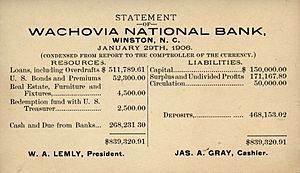Financial statements facts for kids
In business, a financial statement is an organized document that has financial information, like income and transactions, of a person, company, government, or organization. They are used by these people and organizations to make decisions on the subject (the person or organization who the financial statement is about), like whether or not to invest in a company and at what price.
Contents
Basic financial statements
A financial statement can be written in many forms, but in most countries there are four (4) basic financial statements that are standard. They are:
Statement of Financial Position (Balance Sheet)
A Statement of Financial Position (Balance Sheet) is a financial statement that includes everything the business owns (called assets) and the business owes (called liabilities, which also include debts) as at a particular date. The amount the business owes to its owner is called equity (also represents the amount of investment of the owner into the business).
For a private individual (a person not in business), an asset may be their house or car, and their liability may be their mortgage and credit cards.
The Statement of Financial Position is a snapshot of the financial health of a business at specific dates.
Statement of Profit or Loss (Income Statement / Profit or Loss Account)
A Statement of Profit or Loss (or Income Statement) shows the profit or loss made during the year by taking into consideration the revenues generated during the year (whether payment is received or not) less any costs incurred during the year (whether such costs have been settled or not).
Statement of Changes in Equity
A statement of owner's equity shows the movement of the owner's investment in the business. In the case of a company, this separates the investment amount from the amounts included in Capital and Revenue Reserves.
Statement of Cash Flows
A Statement of Cash Flows is a financial statement that shows the transactions involving cash during the year categorized by Operating, Investing and Financing Activities, thus explaining the movement in Cash and Cash Equivalents during the year.
See also
 In Spanish: Estados financieros para niños
In Spanish: Estados financieros para niños


